

San Sisto is a Romanesque-style Roman Catholic church in the town of Viterbo in the Region of Lazio. The church was once known as San Sisto fuori la Porta Romana.


San Sisto is a Romanesque-style Roman Catholic church in the town of Viterbo in the Region of Lazio. The church was once known as San Sisto fuori la Porta Romana.
In Pinzi's 1894 guide to the principal monuments of Viterbo, he cites the presence of an Ancient Roman altar, used as a baptismal font, that this was originally a pagan temple converted into a church by the 5th or 6th century. He also noted a altar composed of early Romaneque decorations and the lombard style bell-tower to assert the presence of a church here by the 7th to 8th centuries. [1]
However the church we see today, likely dates to after the eighth century, when a neighborhood called Vico Quinzano formed in this area, a zone now known as Porta Romana. The first documentation notes a church of San Sisto was present by 1037.
By the 12th-century, under the papacy of Pasquale II, the temple was made a parish church. Subsequent popes added further priveleges, including to perform baptisms. The church underwent numerous refurbishments over the centuries. In May 1944, the church was heavily damaged during an allied bombardment. This refurbishment stripped all of the baroque decorations and many of the side altars that have proliferated over the centuries.
A 19th-century description of the church bemoaned the state of the church: [2]
Later transformations embellished even more brutally, the primitive style of this temple. The vaults were designed to conceal the old skeletal roofs of the aisles: many altars ripped through the majestic nakedness of the walls and insolent masons covered them with mortar giving in to those who can care not a whit how many paintings, inscriptions and other precious memories existed in that place.
The simple facade was reconstructed after the war. The lower of two belltowers dates to the 13th century. The taller belltower, with 19th-century clock, was originally a defensive tower in the city walls. The latest reconstruction removed much of the post-Romanesque additions, including an adjacent nave. The basilica layout has a series of rounded arches, perched on medieval Corinthian columns, flanking the linear central nave, that leads to a series of staircases rising to the altar and apse. The apse once abutted the medieval walls of Viterbo. [3]

The interior contains both a font and an altar derived from Roman spolia. The sole internal altarpiece, dated 1441, is a Madonna and Child, with Saints Sixtus, Felicissima, Lawrence, John the Baptist, Jerome and Nicholas. (1457) by Neri di Bicci. [4] [5] [6] [7]
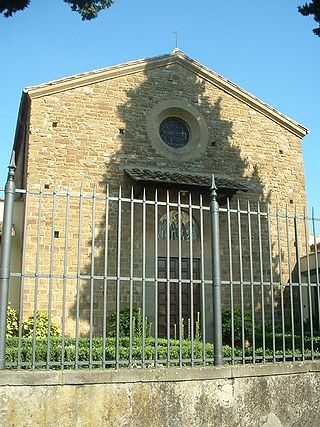
San Leonardo in Arcetri is a Romanesque-style, Roman Catholic church located on Via di San Leonardo #25, a few hundred meters southeast of the Porta San Giorgio of Florence, Italy.

The Church of Santi Giusto e Clemente is a Roman Catholic church in Volterra, Pisa, region of Tuscany, Italy. It is also known as San Giusto or San Giusto Nuovo. For some 850 years, the church was affiliated to an adjacent Benedictine monastery, the Abbey of Sts. Justin and Clement, which is no longer extant.

Santa Maria delle Grazie alle Fornaci fuori Porta Cavalleggeri is a Baroque style, Roman Catholic parish and titular church located at Piazza di Santa Maria alle Fornaci, south of Vatican City and north of the San Pietro train station in the Aurelio quarter. It was made a cardinalate deaconry by Pope John Paul II on 25 May 1985, and assigned it to Cardinal Duraisamy Simon Lourdusamy, then Prefect of the Congregation for the Oriental Churches. The church became vacant on 2 June 2014 after the death of Cardinal Lourdusamy. On November 11, 2016 it was announced that Mario Zenari will succeed him.

The Basilica of San Giovanni Maggiore is a church in Largo San Giovanni Maggiore in central Naples, Italy.

The church of Santi Severino e Sossio and the annexed monastery are located on via Bartolommeo Capasso in Naples, Italy.
Santa Maria della Peste is a small temple-church (tempietto) in Viterbo built at the beginning of the 16th century to give thanks to the Virgin Mary for the ending of the epidemic of 1493–1494. The scourges for that year seem to consist of both syphilis and the bubonic plague. Epidemics recurrently affected towns in Europe over the centuries, with plague affecting Viterbo in 1363, 1374, 1400, 1463, 1476, 1522, 1566, and 1657. The architect is unknown, but the octagonal layout with a small domed roof recalls another contemporary Renaissance tempietto by Bramante at San Pietro in Montorio in Rome. In the last century, the chapel has been rededicated to those who died in wars.
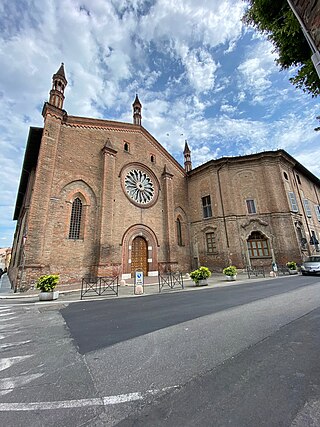
Sant'Anna is a Gothic style, Roman Catholic parish church, located at Via Scalabrini #83 in Piacenza, Region of Emilia Romagna, Italy.
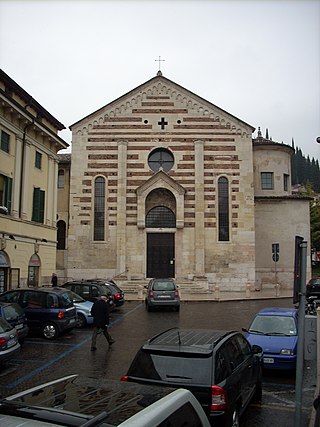
Santo Stefano is a Paleo-Christian, Roman Catholic basilica church in central Verona, region of Veneto, Italy.
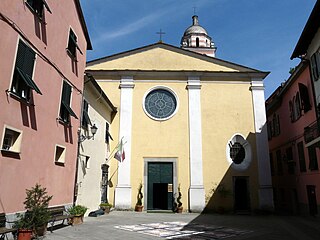
Brugnato Cathedral is a Roman Catholic cathedral located in the old centre of the city of Brugnato, in the Val di Vara in the province of La Spezia, Italy. The dedication is to Saint Peter, Saint Laurence and Saint Columbanus. Once the seat of the bishops of Brugnato, it is now a co-cathedral in the Diocese of La Spezia-Sarzana-Brugnato.

San Martino is a Romanesque-style, Roman Catholic church located in the town of Este in the province of Padua, region of Veneto, Italy.
Santa Maria Assunta di Castelnuovo is a Roman Catholic church located on Via Angelo Giunta in the town limits of Recanati, province of Macerata, in the region of Marche, Italy. It is the oldest church structure in town.

The Ascoli Piceno Baptistery, also known as the baptistery of Saint John, is a religious building found on the eastern end of the piazza Arringo at the center of Ascoli Piceno and sitting next to and just north of the cathedral dedicated to St. Emygdius, the city's patron saint.

Sant'Andrea is a Roman Catholic church located on Via Sant'Andrea in Padua, region of Veneto, Italy. Founded by the 12th-century as a parish church, the present church was completed in the late 19th century.

San Silvestro is a Roman Catholic pieve dedicated to Saint Sylvester located in the municipality of Larciano, in the province of Pistoia, in Tuscany, Italy. The property belongs to the Diocese of San Miniato, Florence.

San Pietro is an ancient Roman Catholic church and former monastery located on piazza San Pietro in central Gubbio, region of Umbria, in Italy. The church which displays architectural elements from many centuries, from Romanesque to the Renaissance, as well as housing prominent artworks; the monastery now houses the civic Biblioteca Comunale Sperelliana.

San Giovanni in Zoccoli is an Romanesque and Gothic-style, Roman Catholic church located in Via Mazzini #8 in Viterbo in the Region of Lazio, Italy.
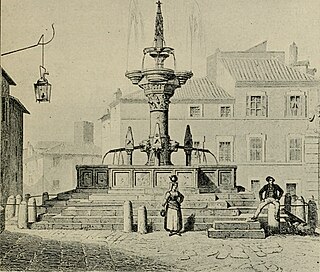
Fontana Grande or Large Fountain is a medieval fountain located in a piazza of the same name, and the intersection of via Garibaldi and via Cavour, in the historic center of Viterbo, region of Lazio, Italy.
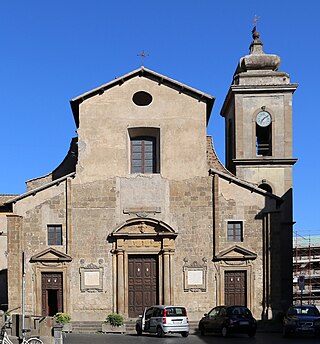
Santi Faustino e Giovita is a refurbished Romanesque-style, Roman Catholic church located on Piazza San Faustino in Viterbo, region of Lazio, Italy. The church is dedicated to the early Christian martyrs, Faustinus and Jovita.

The Fontana di Piazza della Rocca, sometimes shortened to Fontana della Rocca and once called Fontana di San Pietro alla Rocca, is a Renaissance-style fountain located in a piazza in front of the Rocca Albornoz, the Porta Fiorentina, and the Palazzo Grandori, in the northern sector of historic Viterbo, region of Lazio, Italy.
San Carlo is a Romanesque-style, deconsecrated Roman Catholic church in the south-western edge of historic Viterbo, regio of Lazio, Italy. The church is now used as a classroom-auditorium for the Faculty of Political Sciences of the University of Tuscia. The adjacent cloister is used mainly for offices.